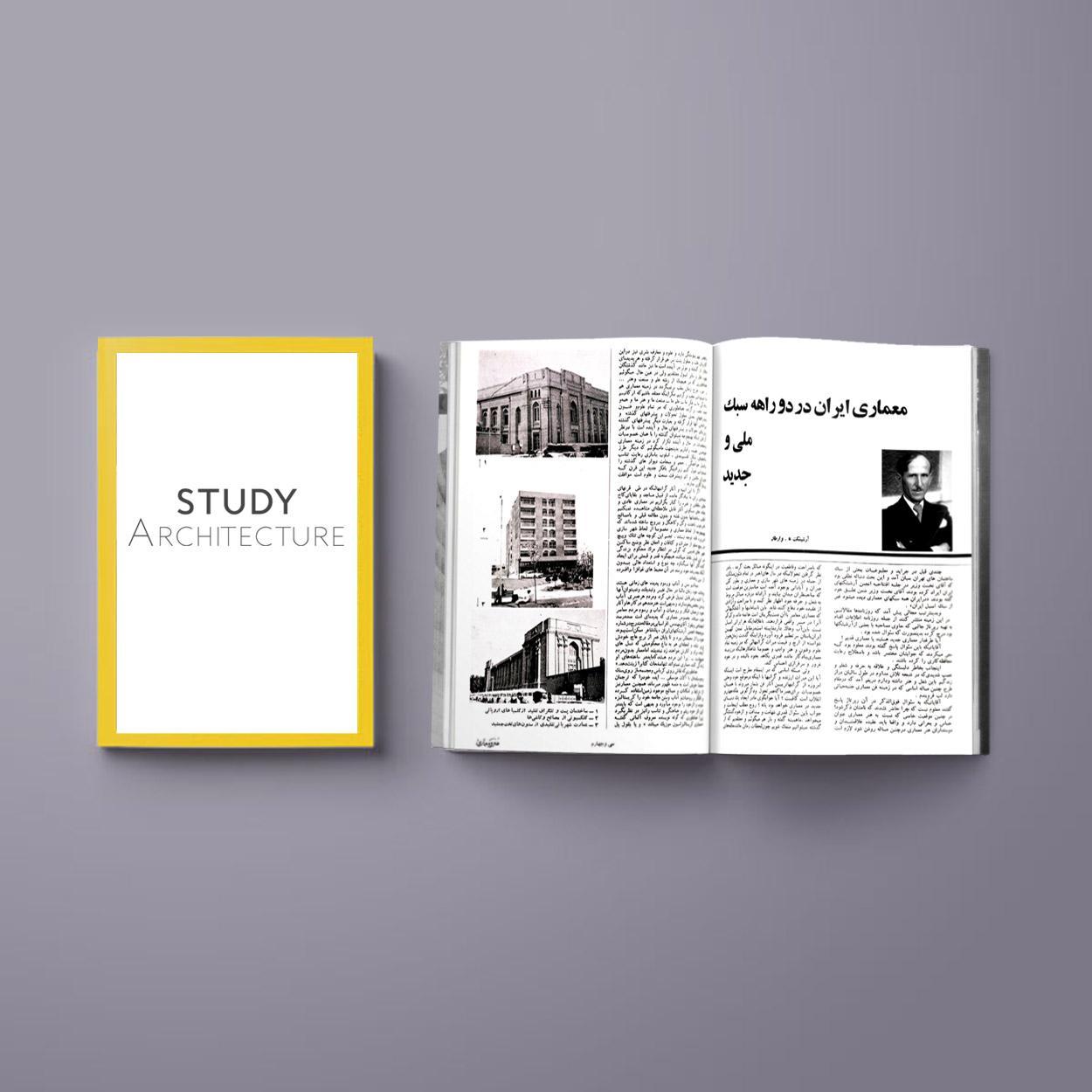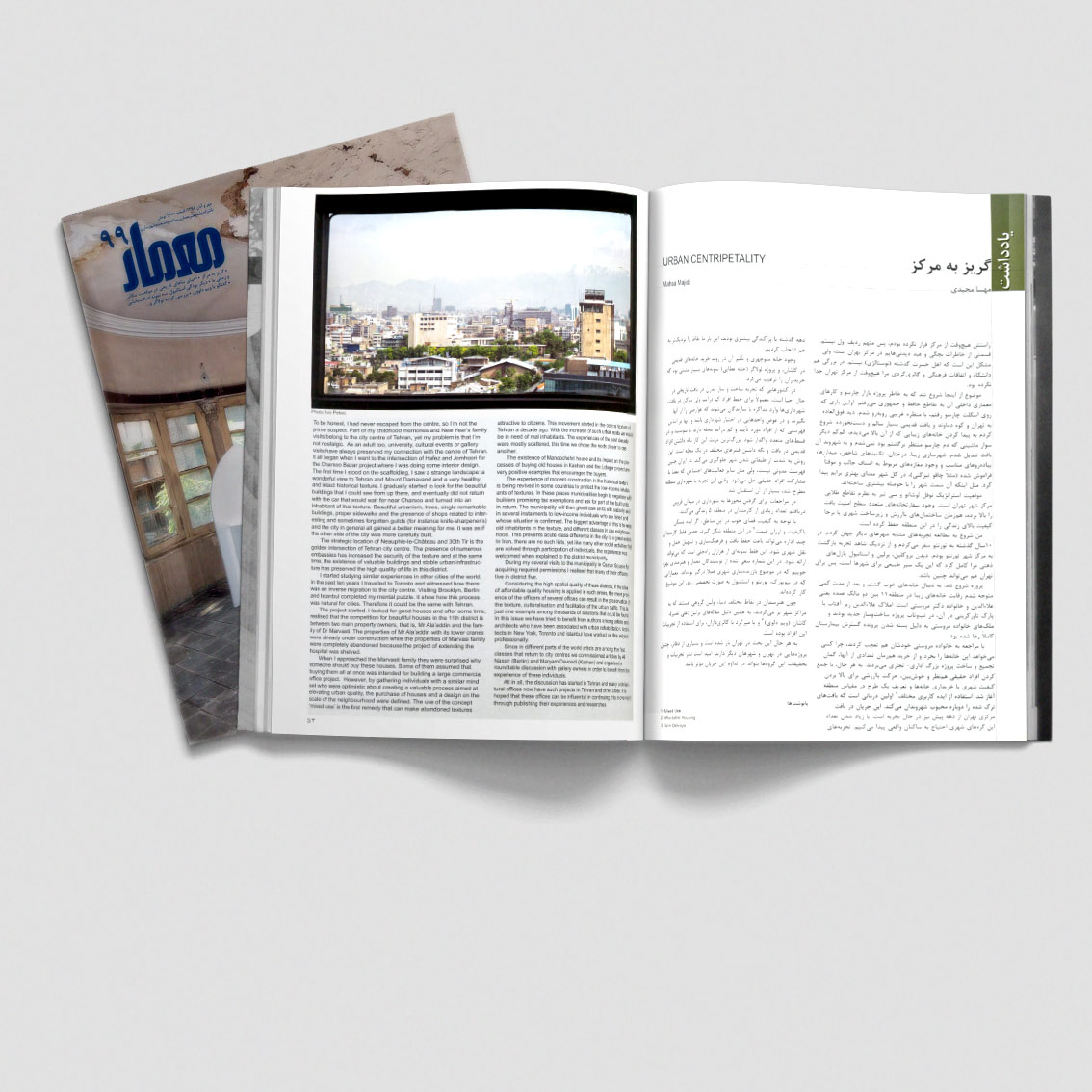Study
گریز به مرکز
مهسا مجیدی
مجله معمار شماره 99 مهر و آبان 95 - صفحات 2-3
Urban Centripetality - Mahsa Majidi
Memar Magazine No.99
راستش هیچ وقت از مرکز فرار نکرده بودم، پس متهم ردیف اول نیستم. قسمتی از خاطرات بچگی و عید دیدنی هایم در مرکز تهران است، ولی مشکل این است که اهل حسرت گذشته (نوستالژی) نیستم. در بزرگی هم دانشگاه و اتفاقات فرهنگی و گالری گردی مرا هیچ وقت از مرکز تهران جدا نکرده بود.
موضوع از اینجا شروع شد که به خاطر پروژه بازار چارسو و کارهای معماری داخلی آن به تقاطع حافظ و جمهوری میرفتم. اولین باری که روی اسکلت چارسو رفتم، با منظره غریبی روبه رو شدم. دید فوق العاده به تهران و کوه دماوند و بافت قدیمی بسیار سالم و دست نخورده. شروع کردم به پیدا کردن خانه های زیبایی که از آن بالا می دیدم، کم کم دیگر سوار ماشینی که دم چارسو منتظر برگشتم بود نمی شدم و به شهروند آن بافت تبدیل شدم. شهرسازی زیبا، درختان، تک بناهای شاخص، میدان ها، پیاده روهای مناسب و وجود مغازه های مربوط به اصناف جالب و موقتا فراموش شده (مثلا چاقو تیز کنی)، در كل شهر معنای بهتری برایم پیدا کرد. مثل اینکه آن سمت شهر را با حوصله بیشتری ساخته اند.
موقعیت استراتژیک نوفل لوشاتو و سی تیر به نظرم تقاطع طلایی مرکز شهر تهران است. وجود سفارتخانه های متعدد سطح امنیت بافت را بالا برده، هم زمان ساختمان های با ارزش و زیرساخت شهری پا برجا کیفیت بالای زندگی را در این منطقه حفظ کرده است.
من شروع به مطالعه تجربه های مشابه شهرهای دیگر جهان کردم. در ۱۰ سال گذشته به تورنتو سفر می کردم و از نزدیک شاهد تجربه بازگشت به مرکز شهر تورنتو بودم. دیدن بروکلین، برلین و استانبول پازل های ذهنی مرا کامل کرد که این یک سیر طبیعی برای شهرها است، پس برای تهران هم می تواند چنین باشد.
پروژه شروع شد. به دنبال خانه های خوب گشتم و بعد از مدت کمی متوجه شدم رقابت خانه های زیبا در منطقه ۱۱ بین دو مالک عمده یعنی علاء الدين و خانواده دکتر مروستی است. املاک علاء الدین زیر آفتاب با پارک تاور کرینی در آن، در تب و تاب پروژه ساخت و ساز جدید بودند و ملکهای خانواده مروستی به دلیل بسته شدن پرونده گسترش بیمارستان کاملا رها شده بود.
با مراجعه به خانواده مروستی خودشان هم تعجب کردند، چرا کسی می خواهد این خانه ها را بخرد و از خرید هم زمان تعدادی از آنها، گمان تجميع و ساخت پروژه بزرگ اداری - تجاری می بردند. به هر حال، با جمع کردن افراد حقیقی هم نظر و خوش بین، حرکت با ارزشی برای بالا بردن کیفیت شهری با خریداری خانه ها و تعریف یک طرح در مقیاس منطقه آغاز شد. استفاده از ایده کاربری مختلف1 اولین درمانی است که بافت های ترک شده را دوباره محبوب شهروندان می کند. این جریان در بافت مرکزی تهران از دهه پیش نیز در حال تجربه است. با زیاد شدن تعداد این گره های شهری احتیاج به ساکنان واقعی پیدا می کنیم. تجربه های دهه گذشته با پراکندگی بیشتری بودند، این بار ما نقاط را نزدیک تر به هم انتخاب کردیم.
وجود خانه منوچهری و تأثیر آن در روند خرید خانه های قدیمی در کاشان، و پروژه لولاگر (خانه عطایی) نمونه های بسیار مثبتی بود که خریداران را ترغیب می کرد.
در کشورهایی که تجربه ساخت و ساز مدرن در بافت تاریخی در حال احیا است، معمولا برای حفظ افراد کم درآمد ولی ساکن در بافت، شهرداریها وارد مذاکره با سازندگان می شوند که عوارضی را از آنها نگیرند و در عوض واحدهایی در اختیار شهرداری باشد و آنها بر اساس فهرستی که از افراد مورد تأیید و کم درآمد محله دارند با سوبسید و در قسط های متعدد واگذار شود. بزرگترین مزیت این کار نگه داشتن افراد قدیمی در بافت و نگه داشتن قشرهای مختلف در یک محله است. این روش به شدت از طبقاتی شدن شهر جلوگیری می کند. در ایران چنین فهرست مدونی نیست، ولی مثل سایر فعالیتهای اجتماعی که بعضا با مشارکت افراد حقیقی حل می شود، وقتی این تجربه با شهرداری منطقه مطرح شد، بسیار از آن استقبال شد.در مراجعات برای گرفتن مجوزها به شهرداری در میدان قزوین دریافتم تعداد زیادی از کارمندان در منطقه ۵ زندگی می کنند.
با توجه به کیفیت فضای خوب در این مناطق، اگر ایده مسکن باکیفیت و ارزان قیمت2 در این منطقه شکل گیرد، حضور فقط کارمندان چند اداره می تواند باعث حفظ بافت و فرهنگ سازی و تسهیل حمل و نقل شهری شود. این فقط نمونه ای از هزاران راه حلی است که می تواند ارائه شود. در این شماره سعی شده از نویسندگان معمار و هنرمندی بهره جوییم که در موضوع باززنده سازی شهری عملا درگیر بوده اند. معمارانی که در نیویورک، تورنتو و استانبول به صورت تخصصی روی این موضوع کار کرده اند.
چون هنرمندان در نقاط مختلف دنیا، اولین گروهی هستند که به مراکز شهر بر می گردند، به همین دلیل مقاله های برلین (علی نصیر)، کاشان (ویم دلوی) و یا میز گرد با گالری داران، برای استفاده از تجربیات این افراد بوده است.
به هر حال این بحث در تهران باز شده است و بسیاری از دفاتر، چنین پروژه هایی در تهران و شهرهای دیگر دارند. امید است نشر تجربیات و تحقیقات این گروه ها بتواند در تداوم این جریان مؤثر باشد.
پانوشت ها:
1 -Mixed Use 2- Affordable Housing 3- Wim Delvoye
To be honest, I had never escaped from the centre, so I'm not the prime suspect. Part of my childhood memories and New Year's family visits belong to the city centre of Tehran, yet my problem is that I'm not nostalgic. As an adult too, university, cultural events or gallery visits have always preserved my connection with the centre of Tehran. It all began when I went to the intersection of Hafez and Jomhoori for the Charsoo Bazar project where I was doing some interior design. The first time I stood on the scaffolding, I saw a strange landscape: a wonderful view to Tehran and Mount Damavand and a very healthy and intact historical texture. I gradually started to look for the beautiful buildings that I could see from up there, and eventually did not return with the car that would wait for near Charsoo and turned into an inhabitant of that texture. Beautiful urbanism, trees, single remarkable buildings, proper sidewalks and the presence of shops related to interesting and sometimes forgotten guilds (for instance knife-sharpener's) and the city in general all gained a better meaning for me. It was as if the other side of the city was more carefully built.
The strategic location of Neauphle-le-Château and 30th Tir is the golden intersection of Tehran city centre. The presence of numerous embassies has increased the security of the texture and at the same time, the existence of valuable buildings and stable urban infrastructure has preserved the high quality of life in this district. I started studying similar experiences in other cities of the world. In the past ten years I travelled to Toronto and witnessed how there was an inverse migration to the city centre. Visiting Brooklyn, Berlin and Istanbul completed my mental puzzle. It show how this process was natural for cities. Therefore it could be the same with Tehran.
The project started. I looked for good houses and after some time, realised that the competition for beautiful houses in the 11th district is between two main property owners, that is, Mr Ala'addin and the family of Dr Marvasti. The properties of Mr Ala'addin with its tower cranes were already under construction while the properties of Marvasi family were completely abandoned because the project of extending the hospital was shelved. When I approached the Marvasti family they were surprised why someone should buy these houses. Some of them assumed that buying them all at once was intended for building a large commercial office project.
However, by gathering individuals with a similar mind set who were optimistic about creating a valuable process aimed at elevating urban quality, the purchase of houses and a design on the scale of the neighbourhood were defined. The use of the concept 'mixed use' is the first remedy that can make abandoned textures attractive to citizens. This movement started in the central texture of Tehran a decade ago. With the increase of such urban nods we would be in need of real inhabitants. The experiences of the past decade were mostly scattered, this time we chose the nods closer to one another. The existence of Manoochehri house and its impact on the processes of buying old houses in Kashan, and the Lolagar project are very positive examples that encouraged the buyers.
The experience of modern construction in the historical texture is being revived in some countries to protect the low-income inhabitants of textures. In these places municipalities begin to negotiate with builders promising tax exemptions and ask for part of the built units in return. The municipality will then give those units with subsidy and in several instalments to low-income individuals who are listed and whose situation is confirmed. The biggest advantage of this is to keep old inhabitants in the texture, and different classes in one neighbourhood. This prevents acute class difference in the city to a great extent. In Iran, there are no such lists, yet like many other social activities that are solved through participation of individuals, the experience was welcomed when explained to the district municipality.
During my several visits to the municipality in Qazvin Square for acquiring required permissions I realised that many of their officers live in district five.
Considering the high spatial quality of these districts, if the idea of affordable quality housing is applied in such areas, the mere presence of the officers of several offices can result in the preservation of the texture, culturalisation and facilitation of the urban traffic. This is just one example among thousands of solutions that could be found. In this issue we have tried to benefit from authors among artists and architects who have been associated with urban rehabilitation.
Architects in New York, Toronto and Istanbul have worked on this subject professionally.
Since in different parts of the world artists are among the first classes that return to city centres we commissioned articles by Ali Nassir (Berlin) and Maryam Davoodi (Kashan) and organised a roundtable discussion with gallery owners in order to benefit from the experience of these individuals. All in all, the discussion has started in Tehran and many architectural offices now have such projects in Tehran and other cities. It is hoped that these offices can be influential in continuing this movement through publishing their experiences and researches.
موضاعات مرتبط: ریسمان های نامرئی قوی ترین گره ها هستند: بررسی کوچه لولاگر،دفتر معماری باغ ایرانی،
Related items: Persian Garden Studio , Invisible Ropes Create the strongest knots: Analysis of lolagar alley


